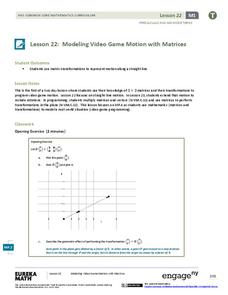Illustrative Mathematics
Making S'Mores
Fifth graders will be clamoring for s'more fractions after they finish this one! Motivated by a chocolate bar used for a yummy campfire treat, learners have to decide how to add fractions without like denominators by discovering the...
EngageNY
Structure in Graphs of Polynomial Functions
Don't allow those polynomial functions to misbehave! Understand the end behavior of a polynomial function based on the degree and leading coefficient. Learners examine the patterns of even and odd degree polynomials and apply them to...
Curated OER
The Art of Interpreting Percent
Ddefine the relationships between fractions, decimals, and percentages in a series of lessons. The class practices converting between these three versions of a number. They also find the common factor of a numerator and denominator and...
Curated OER
Factors
In this factors instructional activity, students identify factors of given numbers. They identify prime numbers and name the least common multiple. This two-page instructional activity contains 24 problems. This instructional activity is...
Curated OER
Abiotic and Biotic Factors
Learners examine abiotic and biotic factors. They define biotic and abiotic, categorize a list of items onto a Venn diagram, label various items from areas on the school grounds as biotic or abiotic, and diagram a magazine picture.
Curated OER
Addition of Decimal Numbers and a Common Factor
Students use video clips to help them understand decimal addition and errors in decimal equations. In this decimal addition lesson, students watch and complete several videos about decimal addition. Students also complete two assessment...
Curated OER
Prairie In A Bottle
Second graders observe images of prairie ecosystems and discuss the needs of living things. They create a prairie habitat in a closed jar to observe the water cycle and plant growth.
El Paso Community College
Factoring
Factoring polynomials is an important skill through high school math and beyond. It provides instructions for the basic types of factoring and a practice set with an answer key.
Curriculum Corner
Fraction Brochures
Make fractions fun and interesting by using a brochure form. Young mathematicians practice and gain a better understanding of how to add and subtract fractions, simplify fractions, and find LCD (least common denominator). The resources...
EngageNY
Mid-Module Assessment Task: Grade 7 Mathematics Module 3
Lesson 16 in the series of 28 is a mid-module assessment. Learners simplify expressions, write and solve equations, and write and solve inequalities. Most questions begin as word problems adding a critical thinking component to the...
EngageNY
Fraction Multiplication and the Products of Decimals
Class members come up with a hypothesis on the number of decimal digits in the product of two decimals. Learners work in groups to complete several decimal multiplication problems. The results help groups develop a conjecture on the...
Willow Tree
Dimensional Analysis
Convey to your pupils the importance of units, then show how to use dimensional analysis to perform a unit conversion. The math lesson includes detailed worked-out solutions to guide learners in their practice.
Noyce Foundation
Photographs
Scaling needs to be picture perfect. Pupils use proportional reasoning to find the missing dimension of a photo. Class members determine the sizes of paper needed for two configurations of pictures in the short assessment task.
EngageNY
Choice of Unit
Explore using units with scientific notation to communicate numbers effectively. Individuals choose appropriate units to express numbers in a real-life situation. For this 13th lesson of 15, participants convert numbers in scientific...
Curated OER
Twenty Questions: The Hundred Chart
Use the 20 Questions game to practice math vocabulary and number properties! Project a hundreds chart and hand one out to learners. Ideally, give them counters (beans would work well) to mark off the chart so you can play multiple times....
EngageNY
Equivalent Ratios II
What is the connection between equivalent ratios? Class members first find the multiplication factor used to create equivalent ratios. Next, they take that information to determine whether ratios are equivalent. The second instructional...
Curated OER
Identify the Common Property in Twelve Octagons
In this Octagon Puzzle worksheet, learners determine the common property for the given numbers in each of twelve octagon. The solutions are provided.
Curated OER
Addition and Subtraction of Rational Expressions
For this rational expressions worksheet, 9th graders solve and complete 15 different problems that include adding and subtracting rational expressions. First, they define Least Common Multiple to get a common denominator in an equation....
Curated OER
Add Fractions With Like Denominators (B)
In this adding fractions worksheet, students view a review and add fractions with common denominators and convert the answers. Students solve fourteen problems.
Curated OER
Add Fractions With Like Denominators ©
In this adding fractions worksheet, students find the sums of fractions with common denominators and rename and reduce the answers. Students solve 14 problems.
Curated OER
Math Review
In this algebra worksheet, students review least common multiples and word problems. There are 10 interactive questions with an answer key.
EngageNY
Dilations from Different Centers
Can you follow a composition of transformations, or better yet construct them? Young mathematicians analyze the composition of dilations, examining both the scale factor and centers of dilations. They discover relationships for both and...
EngageNY
Modeling Video Game Motion with Matrices 1
Video game characters move straight with matrices. The first day of a two-day lesson introduces the class to linear transformations that produce straight line motion. The 23rd part in a 32-part series has pupils determine the...
Mathematics Vision Project
Module 7: Structure of Expressions
The structure of an expression is a descriptive feature. Learners build a solid understanding of quadratic functions using an analysis of expressions in different forms. The seventh module in a series of nine includes 12 lessons...

























